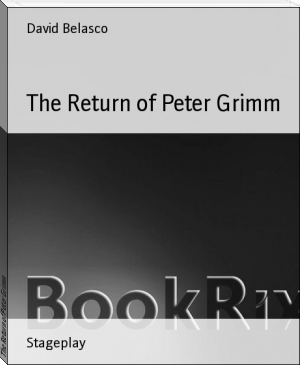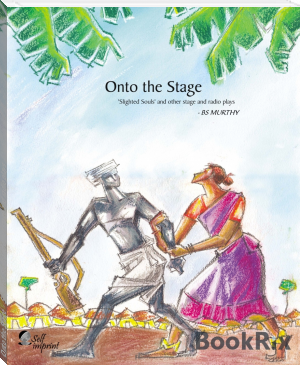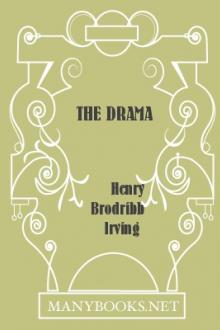The Return of Peter Grimm by David Belasco (classic reads .TXT) 📕

Read free book «The Return of Peter Grimm by David Belasco (classic reads .TXT) 📕» - read online or download for free at americanlibrarybooks.com
- Author: David Belasco
Read book online «The Return of Peter Grimm by David Belasco (classic reads .TXT) 📕». Author - David Belasco
DAVID BELASCO
(Born, San Francisco, July 25, 1853)
The present Editor has had many opportunities of studying the theatre side of David Belasco. He has been privileged to hear expressed, by this Edison of our stage, diverse opinions about plays and players of the past, and about insurgent experiments of the immediate hour. He has always found a man quickly responsive to the best memories of the past, an artist naively childlike in his love of the theatre, shaped by old conventions and modified by new inventions. Belasco is the one individual manager to-day who has a workshop of his own; he is pre-eminently a creator, whereas his contemporaries, like Charles Frohman, were emphatically manufacturers of goods in the amusement line.
Such a man is entitled to deep respect, for the "carry-on" spirit with which he holds aloft the banner used by Boucicault, Wallack, Palmer, and Daly. It is wrong to credit him with deafness to innovation, with blindness to new combinations. He is neither of these. It is difficult to find a manager more willing to take infinite pains for effect, with no heed to the cost; it is impossible to place above him a director more successful in creating atmosphere and in procuring unity of cooperation from his staff. No one, unless it be Winthrop Ames, gives more personal care to a production than David Belasco. Considering that he was reared in the commercial theatre, his position is unique and distinctive.
In the years to come, when students enter the Columbia University Dramatic Museum, founded by Professor Brander Matthews, they will be able to judge, from the model of the stage set for "Peter Grimm," exactly how far David Belasco's much-talked-of realism went; they will rightly regard it as the high point in accomplishment before the advent of the "new" scenery, whose philosophy Belasco understands, but whose artistic spirit he cannot accept. Maybe, by that time, there will be preserved for close examination the manuscripts of Belasco's plays--models of thoroughness, of managerial foresight. The present Editor had occasion once to go through these typewritten copies; and there remains impressed on the memory the detailed exposition in "The Darling of the Gods." Here was not only indicated every shade of lighting, but the minute stage business for acting, revealing how wholly the manager gave himself over to the creation of atmosphere. I examined a mass of data--"boot plots," "light plots," "costume designs." Were the play ever published in this form, while it might confuse the general reader, it would enlighten the specialist. It would be a key to realistic stage management, in which Belasco excels. Whether it be his own play, or that of some outsider, with whom, in the final product, Belasco always collaborates, the manuscripts, constituting his producing library, are evidence of his instinctive eye for stage effect.
The details in the career of David Belasco are easily accessible. It is most unfortunate that the stupendous record of his life's accomplishment thus far, which, in two voluminous books, constituted the final labour of the late William Winter, is not more truly reflective of the man and his work. It fails to reproduce the flavour of the dramatic periods through which Belasco passed, in his association with Dion Boucicault as private secretary, in his work with James A. Herne at Baldwin's Theatre, in San Francisco, in his pioneer realism at the old New York Madison Square Theatre, when the Mallory Brothers were managers, Steele Mackaye was one of the stock dramatists, Henry DeMille was getting ready for collaboration with Belasco, Daniel Frohman was house-manager and Charles Frohman was out on the road, trying his abilities as advance-man for Wallack and Madison Square successes. Winter's life is orderly and matter-of-fact; Belasco's real life has always been melodramatic and colourful.
His early struggles in San Francisco, his initial attempts at playwriting, his intercourse with all the big actors of the golden period of the '60's--Mr. Belasco has written about them in a series of magazine reminiscences, which, if they are lacking in exact sequence, are measure of his type of mind, of his vivid memory, of his personal opinions.
Belasco has reached his position through independence which, in the '90's, brought down upon him the relentless antagonism of the Theatrical Trust--a combine of managers that feared the advent of so individualistic a playwright and manager. They feared his ability to do so many things well, and they disliked the way the public supported him. This struggle, tempestuous and prolonged, is in the records.
A man who has any supreme, absorbing interest at all is one who thrives on vagaries. Whatever Belasco has touched since his days of apprenticeship in San Francisco, he has succeeded in imposing upon it what is popularly called "the Belasco atmosphere." Though he had done a staggering amount of work before coming to New York, and though, when he went to the Lyceum Theatre, he and Henry DeMille won reputation by collaborating in "The Wife," "Lord Chumley," "The Charity Ball," and "Men and Women," he was probably first individualized in the minds of present-day theatregoers when Mrs. Leslie Carter made a sensational swing across stage, holding on to the clapper of a bell in "The Heart of Maryland." Even thus early, he was displaying characteristics for which, in later days, he remained unexcelled. He was helping Bronson Howard to touch up "Baron Rudolph," "The Banker's Daughter" and "The Young Mrs. Winthrop;" he was succeeding with a dramatization of H. Rider Haggard's "She," where William Gillette had failed in the attempt.
"The Heart of Maryland" established both Belasco and Mrs. Carter. Then he started on that extravagant period of spectacular drama, which gave to the stage such memorable pictures as "Du Barry," with Mrs. Carter, and "The Darling of the Gods," with Blanche Bates. In such pieces he literally threw away the possibilities of profit, in order to gratify his decorative sense. Out of that time came two distinctive pieces--one, the exquisitely poignant "Madame Butterfly" and the other, "The Girl of the Golden West"-- both giving inspiration to the composer, Puccini, who discovered that a Belasco play was better suited for the purposes of colourful Italian opera than any other American dramas he examined.
Counting his western vicissitudes as one period, and the early New York days as a second, one might say that in the third period David Belasco exhibited those excellences and limitations which were thereafter to mark him and shape all his work. There is an Oriental love of colour and effect in all he does; but there is no monotony about it. "The Darling of the Gods" was different from "The Girl of the Golden West," and both were distinct from "The Rose of the Rancho." It is this scenic decorativeness which has enriched many a slim piece, accepted by him for presentation, and such a play has always been given that care and attention which has turned it eventually into a Belasco "offering." None of his collaborators will gainsay this genius of his. John Luther Long's novel was unerringly dramatized; Richard Walton Tully, when he left the Belasco fold, imitated the Belasco manner, in "The Bird of Paradise" and "Omar, the Tentmaker." And that same ability Belasco possesses to dissect the heart of a romantic piece was carried by him into war drama, and into parlour comedies, and plays of business condition. I doubt whether "The Auctioneer" would read well, or, for the matter of that, "The Music Master;" Charles Klein has written more coherent dialogue than is to be found in these early pieces. But they are vivid in mind because of Belasco's management, and because he saw them fitted to the unique figure of David Warfield.
But a Belasco success is furthered by the tremendous public curiosity that follows him in all he does. There is a wizardry about him which fascinates, and makes excellent reading in the press. Long before I saw the three-winged screen upon which it is his custom to sort out and pin up his random notes for a play, it was featured in the press. So were pictures of his "collection," in rooms adjoining his studio--especially his Napoleonic treasures which are a by-product of his Du Barry days. No man of the theatre is more constantly on the job than he. It is said that old John Dee, the famous astrologer whom Queen Elizabeth so often consulted, produced plays when he was a student at Cambridge University, with stage effects which only one gifted in the secrets of magic could have consummated. Belasco paints with an electric switchboard, until the emotion of his play is unmistakably impressed upon the eye. At a moment's notice he will root out his proscenium arch, and build a "frame" which obliterates the footlights; at another time he will build an "apron" to his stage, not for its historical significance, but merely to give depth and mellowness to such an ecclesiastical picture as Knoblauch's "Marie-Odile." He has spent whole nights alone in the theatre auditorium with his electrician, "feeling" for the "siesta" somnolence which carried his audience instantly into the Spanish heat of old California, in "The Rose of the Rancho;" and the moving scenery which took the onlooker from the foot-hills of the Sierras to the cabin of "The Girl of the Golden West" was a "trick" well worth the experiment.
Thus, no manager is more ingenious, more resourceful than David Belasco. But his care for detail is often a danger; he does not know fully the value of elimination; the eye of the observer is often worried by the multiplicity of detail, where reticence would have been more quickly effective. This is the Oriental in Belasco. His is a strange blend of realism and decorativeness.
"A young man came to me once," he said to me, "with the manuscript of a new play, which had possibilities in it. But after I had talked with him awhile, I found him preaching the doctrines of the 'new' art. So I said to him, 'My dear sir, here is your manuscript. The first scene calls for a tenement-house set. How would you mount it?'"
He smiled, maybe at the recollection of Gordon Craig's statements that "actuality, accuracy of detail, are useless on the stage," and that "all is a matter of proportion and nothing to do with actuality."
"I felt," Mr. Belasco continued, "that the young man would find difficulty in reconciling the nebulous perspectives of Mr. Craig with the squalor of a city block. I said to him, 'I have been producing for many years, and I have mounted various plays calling for differing atmospheres. I don't want to destroy your ideals regarding the 'new art', but I want you to realize that a manager has to conform his taste to the material he has in hand. I consider that one of the most truthful sets I have ever had on the stage was the one for the second act of Eugene Walter's 'The Easiest Way'. A boarding-house room on the top floor cannot be treated in any other way than as a boarding-house room. And should I take liberties with what we know for a fact exists in New York, on Seventh Avenue, just off Broadway, then I am a bad producer and do not know my business. I do not say there is no suggestion in realism; it is unwise to clutter the stage with needless detail. But we cannot idealize a little sordid ice-box where a working girl keeps her miserable supper; we cannot symbolize a broken jug standing in a wash-basin of loud design. Those are the necessary evils of a boarding-house, and I must





Comments (0)